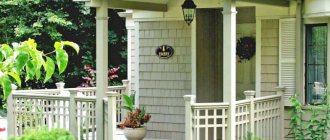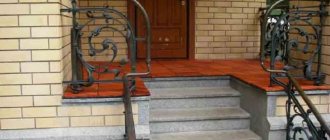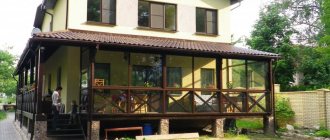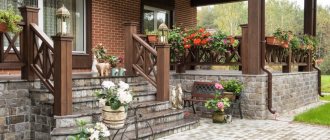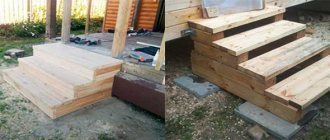What is a porch, why does it exist and what functions does it perform?
The porch is an extension to the house, which, through steps, makes it easier to enter/exit the doors. Since the porch usually has a canopy, this provides additional protection for the doorway from the sun, rain and snow.
In addition, the porch acts as a decorative element that makes the exterior of the house complete and makes its operation convenient.
As a rule, the parameters of the porch are thought out at the stage of building a house, cottage or cottage. But often a porch is attached to an existing structure.
Traditionally, to build a porch in front of a house, the same material from which it is built is used (for example, a wooden or brick house). The porch can be made of wood, concrete, metal, brick. It is important that the selected material (for steps, cladding, porch finishing) is in harmony with the overall design of the house.
Due to the fact that wood is the most popular, as well as accessible and inexpensive material, porches are most often built from wood. Therefore, we will consider in detail (step by step) how to organize the construction of a wooden porch. Another argument in favor of lumber is the ease of working with wood, which makes it possible to make a wooden porch with your own hands.
Wooden porch for a private house - project
Construction begins with the development of a project that takes into account:
Types of porch
- Regular (simple porch), consisting of several steps, with open or closed risers, with or without railings. A simple wooden porch is low and lacks a wide deck.
Neat little porch
Wooden porch with railings
Wooden porch without railings
Wooden porch of classic shape
- Porch-patio, i.e. a porch with a platform intended for installing pots of flowers or arranging a resting place.
Wooden porch-patio
Porch-patio with wooden platform
Porch-patio with fenced area
Porch-patio with massive steps
- Porch-terrace or veranda. In this case, the porch is combined with the open space of the house.
Wooden porch-terrace
Wooden porch-veranda
Porch design
- built-in porch - built together with the house, has a common foundation with it;
- attached (attached porch) - completed during the operation of the house.
Material for porches in a private house
- tree;
- concrete;
- metal (forging, steel, iron);
- brick (stone).
Methods for constructing a wooden porch
Possible implementation in two versions:
- On a site with straight and beveled frames
Straight porch frame - diagram
Straight porch frame - drawing
Sloped porch frame - diagram
Sloped porch frame - drawing
This method is simpler and consists in installing a wooden box (or a porch frame made of a metal profile) on the prepared site, on which steps are installed.
This option is also more budget-friendly; it can be implemented at any stage of construction or operation of the house. A closed wooden porch makes it possible to hide all the flaws that arise during the construction stage;
- On a reinforced stringer or bowstring
Porch frame on reinforced stringer - diagram
Porch frame on reinforced stringer - drawing
The peculiarity of this method is that the base frame is prepared only for the lower part of the stringer/string, and the upper one rests on beams or a floor slab. This method of building a porch provides more opportunities for implementing original solutions.
Types of designs and types
Depending on the stage of construction of a residential building, the structures are:
- simple (platform with stairs on a built separate foundation)
- built-in (the porch is designed and built completely along with the entire building)
- attached (modified structure of a simple type that can be easily disassembled and assembled elsewhere in the house)
A covered porch often transforms into a veranda
The following design options for the house porch are possible:
- Staircase with upper and lower landings. The most common modification: there is an approach to the steps and an exit from them to the door
- Area. Does not involve the installation of stairs (railings and steps) or merges with it structurally. A large area often turns into a veranda where outdoor furniture is installed
- Closed space. A glazed or fenced veranda that serves as a dressing room
- Porch with canopy. The area becomes covered when a canopy is installed over it
- With the addition of a balcony. The balcony attached to the top serves as a canopy over the upper platform, and its supports become structural elements of the staircase
How to make a wooden porch with your own hands without mistakes
Before we tell you how to build a wooden porch, we will describe the main mistakes that novice craftsmen may encounter.
- stylistic errors. The dimensions, appearance, and material of the porch must be in harmony with the general appearance of the building (house design);
- errors in the dimensions of the porch. The porch should be proportional to the main building;
- errors in measurements.
Each parameter is measured several times and plotted on the diagram;> Note. Professionals advise putting on the diagram not only the dimensions of the porch and wooden frame, but also other parameters: the size of the doorway, the distance from the porch to the plants or protruding decorative elements. This information will be useful if necessary to correct the porch drawing. - excess material consumption. Eliminated through careful planning.
- ignoring the requirements for structural strength. The porch is the most used part of the building. In addition, it is exposed to external factors, which means the material must be selected with a margin of safety and taking into account the dimensions of the porch;
- provide additional protection to a wooden porch.
Untreated wood gradually loses its properties, so it needs protection and constant care; Note. Both open parts of the structure and load-bearing parts need protection, i.e. those that are placed in the ground or rest on a foundation.
- separation of the foundations of the house and the porch (on different (separate) foundations) will lead to uneven shrinkage of the porch and the appearance of a crack between the elements. This can be avoided by a threshold installed at the junction of the porch and the house. Or installing a threshold without a march, with the first step 150-170 mm below the threshold. But this is fraught with injury, since when leaving the door, the user is forced to go down;
- the absence of a foundation leads to the fact that the porch “floats” under the influence of soil displacement (shear);
- jamming of doors (blocking, jamming). Occurs due to geological changes (frozen soil can raise the porch a couple of centimeters).
How to properly build a porch for a house
Stylistics, textures
The decoration of the veranda must correspond to the general style of all elements of the territory:
- façade;
- fencing;
- gate.
The following basic styles can be identified; design solutions will be outlined below. But the combination of different textures looks interesting.
For example, a path that smoothly turns into brick railings with wooden balusters. Try to smooth out the sharp roof with the smooth shapes of the path, and connect the round balcony and rectangular steps with the sidewalk.
The decoration of the veranda must correspond to the general style of all elements of the territory
Classical
Characteristic features: strict, seasoned, moderate style . The extension is equipped with a gable roof, which can be supplemented with beautiful columns and railings with rounded balusters. Facing materials suitable for classicism - natural stones, ceramics, painted wood.
Strict, seasoned, moderate style
Russian style
The entrance has long been distinguished by its sophistication. The extension is decorated:
- carved elements;
- turned balusters;
- pillars made in complex shapes;
- various ornate patterns.
Now the Russian style is especially popular. It involves the use of natural materials and handmade decor.
In Russian style
Middle Ages
Quite a modern style. This veranda is similar to ancient fortresses, which are decorated with natural stone. You can decorate the front entrance with torch lamps, forged gratings, and rough-hewn logs.
This type will attract the attention of others with its luxury.
This veranda is similar to ancient fortresses
Country
A wooden structure with carved pillars and railings. For decoration, you should use the maximum number of colors in a variety of readings:
- Hanging flowerpots.
- Containers with flyers.
- Decoupage with flowers.
- Dried flower compositions.
Country style
European
Distinctive features are the presence of regular shapes and restrained lines . The extension has the appearance of a small, discreet structure, for the cladding of which natural stones and ceramic tiles are used. Figurines and flower pots are used for decoration.
Discreet design
Mediterranean
Has two readings:
Combines Greek and Roman culture. A characteristic feature is a stone courtyard, complemented by multi-tiered steps. Sandstone is used for finishing, and metal elements are used for decoration. A combination of Italian, Spanish, French style. The difference is maximum unevenness and relief. Exterior – open terrace, located in several tiers. The floor area is covered with paving stones, sometimes with clinker. The flooring near the house is made of deck boards. The canopy is built on columns. Concrete balusters are placed throughout the veranda. Fountains, flower tubs, and sculptures are used as decoration.
Mediterranean style
French
One of the varieties of European style with charm. The highlight is the presence of a glass door with an openwork grille. The structure should be decorated with figured elements, beautiful wicker furniture, and a variety of fresh flowers (pots on the floor, hanging vases).
French style
Material for making a porch
To make a beautiful wooden porch you will need building materials:
- For supports, a beam with a cross section of 100x200 mm is suitable. The size depends on the type of porch, the expected load, the number of supports, etc. When choosing wood for supports, it is better to give preference to larch or pine, due to the presence of resins, they can withstand all-season operating conditions well;
- for the entrance platform from the steps you can use a board 30-50 mm thick;
- ready-made balusters and railings. Or timber and lath for their manufacture. The dimensions of the lumber depend on the parameters of the future product.
- solutions, compositions and impregnations for wood protection;
- cement mortar (concrete);
Note. Using 50 mm boards for both supports and steps will allow you to avoid errors in calculations, reduce waste and, in general, use lumber more efficiently.
What finish should I use?
Not all structures have walls and a ceiling, but every one has a floor. Let's talk about him. The finishing of the porch floor must have the following qualities:
- Durability. Provided by resistance to dirt, dust, mechanical stress, acids, fats, etc. For example, untreated wood quickly “shuffles out” and requires additional protection.
- Safety. When there is precipitation or after washing, the porch should not be slippery - this is a problem with some paints and varnishes, as well as glossy tiles and porcelain stoneware.
- Practicality. Rest assured: there will be a lot of dust, dirt, and sand on the horizontal surface near the door. Don’t hope for a miracle, take this point into account in advance and make sure that dirt is easy to remove. For example, pour water from a hose and simply rinse.
Suitable for finishing a porch with steps:
- wood (requires regular treatment after installation);
- decking board made of wood-polymer composite (the decking is easy to clean, lasts a long time, and does not slip);
- tiles (there is a special one for steps; from the usual ones, choose non-slip ones, preferably street ones);
- stone (expensive, but aesthetic pleasure is guaranteed);
- porcelain stoneware (cheaper than stone, more reliable than tiles).
The photo shows a porch with a wooden floor
Drawing of a wooden porch
Even a simple (standard) drawing, drawn independently, will help to avoid difficulties during its construction.
The porch drawing must contain the following information:
- appearance of the porch. Makes it possible to visualize the final appearance of the structure;
- width of the porch - should be one and a half times wider than the doorway (you can calculate how wide the porch should be this way: 1.5 times the width of the door, this will be the minimum allowable width). This width will allow you to open the door while on the porch area;
- The width of the stairs to the porch (flight of stairs) must be at least 700 mm. Otherwise, difficulties will arise when moving people and objects along the steps;
- location of the porch platform (flooring). The porch floor should be 30-50 mm below the threshold (doorway). A lowered porch platform will prevent the doors from blocking due to snow or lifting of the porch structure;
- porch angle;
Note. Professionals advise sloping the porch area and steps by 2-3° to avoid water accumulation. An alternative would be to install deck boards with a gap of 2-3 mm.
- foundation. Types, depth, characteristics of the soil underneath;
- number and size of porch steps. The standard recommends adhering to the following dimensions of steps: height – 170-180 mm, step depth (tread) – 300-350 mm. It is desirable that the number of steps be odd. These dimensions will make movement along the steps comfortable;
- presence and installation location of fencing (balusters and railings).
Note. In construction practice, there are no norms and rules regulating the parameters of the porch. The recommendations concern only the parameters of the steps.
Drawing of a wooden porch, as an illustrative example:
Drawing of a wooden porch with dimensions
Scheme of a wooden porch
It’s convenient when working when the diagram of a wooden porch is made on a large sheet of paper and is always in front of your eyes.
A good alternative would be a life-size cardboard template. A paper template is indispensable when making a flight of stairs on a bowstring.
Porch template
Foundation for the porch of a house
Wooden staircase to the porch A correctly selected and poured foundation for a wooden porch is the key to its strength and durability.
A wooden staircase to the porch can be installed without a foundation. But filling it will prevent the porch from moving due to seasonal soil movement.
When building a porch, you can choose one of the following types of foundation:
Columnar foundation for the porch Columnar. Well suited for lightweight construction. The number of support pillars depends on the size of the porch.
Slab foundation for the porchSlab. Structurally, it is a monolithic concrete slab. Designed for heavy (massive) structures. In most cases, a slab foundation does not need to be tied to the foundation of the main structure (house).
Strip foundation for the porch. Strip foundation. It has a significant margin of safety, while requiring less material costs. Connection to the foundation of the house is required.
Material prepared for the website www.moydomik.net
What kind of foundation is best to pour under the porch?
Some users recommend installing a strip foundation for the porch. In this case, the likelihood of a discrepancy between the porch and the house, as when using a columnar one, is eliminated. It also reduces material consumption compared to slab. The difficulty in arranging this type of foundation is that it needs to be tied to the house.
How to tie (connect) the foundation of the porch and the house?
First of all, adjacent foundations of the porch and house must have the same depth.
It is better not to immediately fill the place where the foundations are attached (fastened, connected), but leave a technical gap (a gap of 20-30 cm), in which there will be connecting elements (studs, reinforcement).
In the old foundation of the house, holes are drilled at a distance of 50-60 mm and studs with expansion anchors are driven in. From the new porch foundation, make a rebar outlet to these studs. Simply fitted (do not twist or weld).
After the new foundation has “settled” (stands) for a year (or at least a winter), preferably under load, the reinforcement can be connected (tied, twisted, welded). Fill the bond with concrete mortar.
The diagram below shows how to make a porch out of wood with the foundation tied to the house.
Linking the foundation of the porch and the house - diagram
Connection of the foundation of the porch and the house - diagram
What is the depth of the foundation for the porch
The depth of the foundation for the porch should correspond to the depth of the foundation of the house and be below the freezing level of the soil.
A strip foundation is certainly an excellent solution for building a porch. However, not everyone needs a massive structure. After all, most porch staircases are built using stringers or bowstrings. In this case, it is not necessary to pour a strip foundation, but give preference to a pile or columnar foundation. When laying out such a foundation, you need to make concrete “pillows” for the supports and the base of the stringer/string.
The method for constructing a concrete pad is shown in the diagram.
Scheme of a porch on a concrete pad
Glazing methods
Making the porch closed is an ideal option, although it will take a lot of money and time. A foundation made of stone or concrete is suitable as a base, and always on piles to reduce the overall load on the base.
It is better to use metal corners as a material for the frame. As a rule, the frame is attached to the piles using electric welding. After this, the structure is filled with wooden frames with double glass.
Important point! The width of glass sheets should not be more than 1 meter 20 centimeters. Since the windage of the structure is quite high, the glass may not withstand the force of the wind if the width of the clean window opening without a frame is greater.
If the distance between the piles is more than 1 meter, then this space should be filled with pseudo-piles. Pseudo-piles are formed using metal corners, which are welded both below and above the piles. The result is a fairly reliable design that looks light and beautiful.
How to build a wooden porch for a house
Let's consider the technology of constructing porches on pillars (piles, supports, beams) made of wood.
The construction of a porch on a foundation in the form of a support cushion for pillars (support pedestals) will be justified only if a number of rules are followed:
- the base of the stringer must rest against the waterproofing laid between the foundation and the wood of the stringer;
- for supports it is better to take coniferous wood, it is preferable in conditions of high humidity;
Advice. When choosing lumber for a support, it is better to give preference not to a 100x100 mm beam, but to two 50x100 boards fastened together.
- the wood of the supports should be treated with an antiseptic;
Note. The support should be processed to a height of 150-200 mm from the soil level. In this case, it is undesirable to use roofing felt. It prevents the flow of air, and the process of wood rotting begins from the inside. It is better to use drying oil or used machine oil.
- installation depth of supports is at least 800 mm;
Advice. Professionals recommend burying racks to a depth equal to 1/3 of the length of the rack.
- the wider and more massive the structure, the more supports there should be;
- After the concrete used to fill the supports has dried, you need to check their height. Adjust the height difference;
- laying the logs on the supports is mandatory. Ideally, the upper edge of the stringer should be secured to a railroad tie.
Laying porch joists on supports
- at the ends of the supports you need to select quarters. This will ensure more reliable fastening of the lags and stringers.
Washed down the stringer of a wooden porch
Note. When making a porch from wood, it is necessary to consider waterproofing and a drainage system. This will avoid distortion of the porch structure.
It is worth noting that there is no fundamental difference in how to build a porch for a wooden or brick house. It is important to make an informed choice of the type of foundation and, if necessary, correctly link it to the foundation of the house.
Flooring the porch landing and installing steps
Users' opinions differ on this issue. Some advise fitting the flooring boards as closely as possible to each other in order to prevent the appearance of cracks typical of dry wood, and also making a slope of 1.5-2° to allow water to flow smoothly from the flooring.
Others recommend leaving a gap of 2-3 mm so that water flows down unhindered. At the same time, they claim that these gaps do not entail the risk of injury when walking on the flooring (except for high-heeled shoes). Wooden steps for the porch - you can buy them ready-made or make them yourself. If the latter option is selected, a detailed description is provided below.
How to make steps for a porch out of wood
Methods for attaching steps to a string. Steps are installed starting from the lower edge of the stringer/string. Fastening is carried out using self-tapping screws, which must be sunk into the wood to avoid injury.
First, the riser is installed, then the step. This is due to the fact that it is easier to maintain the dimensions.
When constructing a staircase on a stringer, the steps are attached to it. Options for attaching the steps to the string are shown in the diagram.
Wooden porch fencing
It is important to note that if a flight of stairs has more than 3 steps, it is advisable to equip it with a fence. The fence for the porch can be metal (forged, stainless steel), wood, brick, stone (or concrete). Wooden railings for the porch can become not only a guarantee of safety of movement, but also an additional decoration.
Decorative wooden porch fencing
Stylized wooden porch fencing
Recommendation. Provide safety elements - anti-slip coating on the porch steps (non-slip, anti-slip, rubber, rubber coating, tiles, mat). After all, frozen moisture (icing) makes movement on them dangerous.
Anti-slip coating on porch steps
We have sorted out the question of how to make a wooden porch; now it is important to study how to extend its service life.
Formwork
The formwork is removed after 7-8 days. Until the mortar has completely hardened, it is better not to step on the steps leading to the house at all to avoid deformation. The cladding begins after the formwork is removed.
In a semicircular shape, the outer edge is decorated with halves of brick, paving slabs or porcelain stoneware. The gaps between the bricks do not exceed 1 cm. Ideally, there are none at all. Next, standard concrete pouring is performed.
Which porch to prefer: wooden, stone, concrete - it’s up to you. We only tried to talk about the most important points that influence the choice of material, about the nuances of construction and operation, and about how to make steps to the house with your own hands. And let your home be one and only!
How to protect a wooden porch - care
A canopy over the porch will protect the wooden steps and the structure as a whole from external factors (sun, snow and rain). A wooden canopy over the porch of a wooden house will look especially good. For buildings made of other materials (for example, for a stone house), polycarbonate, corrugated sheets, tiles or other roofing materials are suitable. The visor can be made with or without stands. The main thing is that the visor supports do not interfere with movement.
Recommendation. It is important to periodically process wood. This is a guarantee that the structure being constructed will not require major repairs for a long time.
Wood processing is divided into pre-operational and operational. The first involves applying special compounds before the construction of the porch begins. The composition of the solutions will reduce the tendency of wood to rot, deform, dry out, etc. And the second will make it possible to preserve the original appearance of the structure. Such processing may include painting, waxing or varnishing.
Protection from negative external conditions
The quality of the material may not be sufficient for the long life of the porch. You can increase it by building a canopy and applying a protective coating to the tree.
Canopy or canopy
The canopy will protect the wood from rain, sunlight, and snow. It is constructed from the following materials:
- polycarbonate;
- wood;
- corrugated sheeting;
- tiles.
Attach the canopy using racks or to the wall of the building. It can also be single or double sloped. It depends on the chosen project.
The canopy is smaller in size than the canopy and can be installed on two brackets.
Painting a wooden porch
- pine wood needs to be exposed (coated) with paint in several layers and the layer periodically renewed;
- Before applying paint, you need to open (treat, impregnate) the wood with a primer;
Advice. The primer will preserve the properties of wood, but the surface will need to be painted every 3-6 years. Without impregnation, the paint will last up to 10 years, but the properties of the wood will deteriorate significantly.
- It is not recommended to coat pine with transparent compounds. Sand and dirt are pressed into the soft rock;
- larch or deciduous wood can be opened with transparent compounds. Vermeister Deck.Oil impregnation oil has proven itself to be excellent;
- When choosing what to paint a wooden porch on the street, you need to know that the compositions for coating the wood outside and inside the house may differ. To paint a wooden porch from the street (outside), use the following paints and enamels:
- oil-based (due to their pungent odor they are gradually losing popularity);
- water-based (need constant updating);
- alkyd (resistant to moisture and mechanical abrasion);
- polyurethane (used mainly in industrial environments);
- reactive (consist of two components; their distribution is limited by high cost and short time for application after mixing the components).
- Each renewal of the coating on wood is carried out only after stripping the surface of the previous layer of old paint.
Concrete steps
Concrete is the best option for a quality porch. One part of cement (grade no lower than M400) is mixed with two parts of sand and two parts of crushed stone. The mixture is not too liquid. The reinforced frame provides additional strength. The main requirement is that metal parts and fittings do not come to the surface. Otherwise, rust formation and structure destruction are inevitable. If the filling technology is followed, there will be no fungus or mold.
Concrete treads do not collapse under the influence of precipitation and can withstand heavy loads and weight. There is no risk that the tread will break or bend when several people move at the same time. Tiles, natural stone or stone chips are used as facing materials.
